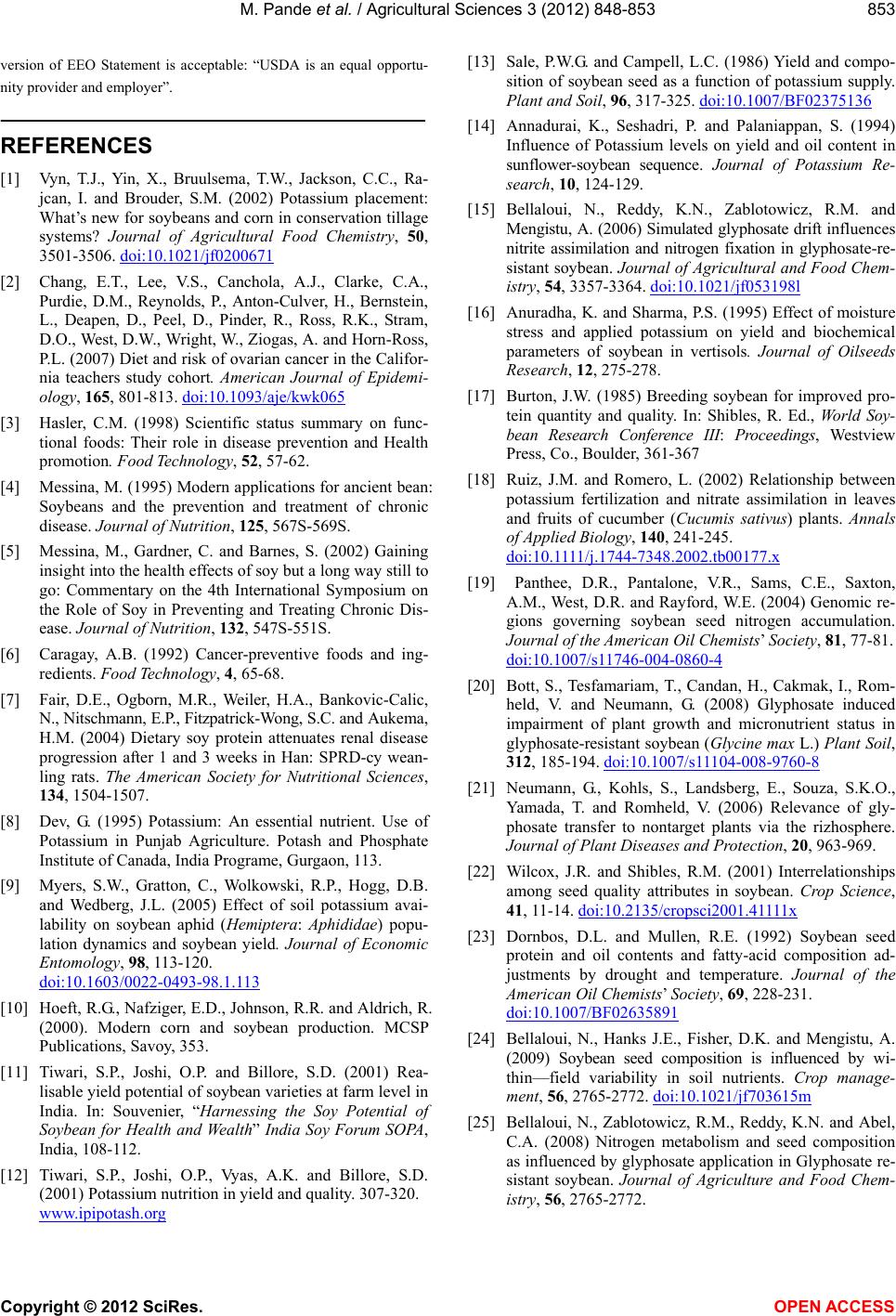
M. Pande et al. / Agricultural Sciences 3 (2012) 848-853 853
version of EEO Statement is acceptable: “USDA is an equal opportu-
nity provider and employer”.
REFERENCES
[1] Vyn, T.J., Yin, X., Bruulsema, T.W., Jackson, C.C., Ra-
jcan, I. and Brouder, S.M. (2002) Potassium placement:
What’s new for soybeans and corn in conservation tillage
systems? Journal of Agricultural Food Chemistry, 50,
3501-3506. doi:10.1021/jf0200671
[2] Chang, E.T., Lee, V.S., Canchola, A.J., Clarke, C.A.,
Purdie, D.M., Reynolds, P., Anton-Culver, H., Bernstein,
L., Deapen, D., Peel, D., Pinder, R., Ross, R.K., Stram,
D.O., West, D.W., Wright, W., Ziogas, A. and Horn-Ross,
P.L. (2007) Diet and risk of ovarian cancer in the Califor-
nia teachers study cohort. American Journal of Epidemi-
ology, 165, 801-813. doi:10.1093/aje/kwk065
[3] Hasler, C.M. (1998) Scientific status summary on func-
tional foods: Their role in disease prevention and Health
promotion. Food Technology, 52, 57-62.
[4] Messina, M. (1995) Modern applications for ancient bean:
Soybeans and the prevention and treatment of chronic
disease. Journal of Nutrition, 125, 567S-569S.
[5] Messina, M., Gardner, C. and Barnes, S. (2002) Gaining
insight into the health effects of soy but a long way still to
go: Commentary on the 4th International Symposium on
the Role of Soy in Preventing and Treating Chronic Dis-
ease. Journal of Nutrition, 132, 547S-551S.
[6] Caragay, A.B. (1992) Cancer-preventive foods and ing-
redients. Fo od Technolog y, 4, 65-68.
[7] Fair, D.E., Ogborn, M.R., Weiler, H.A., Bankovic-Calic,
N., Nitschmann, E.P., Fitzpatrick-Wong, S.C. and Aukema,
H.M. (2004) Dietary soy protein attenuates renal disease
progression after 1 and 3 weeks in Han: SPRD-cy wean-
ling rats. The American Society for Nutritional Sciences,
134, 1504-1507.
[8] Dev, G. (1995) Potassium: An essential nutrient. Use of
Potassium in Punjab Agriculture. Potash and Phosphate
Institute of Canada, India Programe, Gurgaon, 113.
[9] Myers, S.W., Gratton, C., Wolkowski, R.P., Hogg, D.B.
and Wedberg, J.L. (2005) Effect of soil potassium avai-
lability on soybean aphid (Hemiptera: Aphididae) popu-
lation dynamics and soybean yield. Journal of Economic
Entomology, 98, 113-120.
doi:10.1603/0022-0493-98.1.113
[10] Hoeft, R.G., Nafziger, E.D., Johnson, R.R. and Aldrich, R.
(2000). Modern corn and soybean production. MCSP
Publications, Savoy, 353.
[11] Tiwari, S.P., Joshi, O.P. and Billore, S.D. (2001) Rea-
lisable yield potential of soybean varieties at farm level in
India. In: Souvenier, “Harnessing the Soy Potential of
Soybean for Health and Wealth” India Soy Forum SOPA,
India, 108-112.
[12] Tiwari, S.P., Joshi, O.P., Vyas, A.K. and Billore, S.D.
(2001) Potassium nutrition in yield and quality. 307-320.
www.ipipotash.org
[13] Sale, P.W.G. and Campell, L.C. (1986) Yield and compo-
sition of soybean seed as a function of potassium supply.
Plant and Soil, 96, 317-325. doi:10.1007/BF02375136
[14] Annadurai, K., Seshadri, P. and Palaniappan, S. (1994)
Influence of Potassium levels on yield and oil content in
sunflower-soybean sequence. Journal of Potassium Re-
search, 10, 124-129.
[15] Bellaloui, N., Reddy, K.N., Zablotowicz, R.M. and
Mengistu, A. (2006) Simulated glyphosate drift influences
nitrite assimilation and nitrogen fixation in glyphosate-re-
sistant soybean. Journal of Agricultural and Food Chem-
istry, 54, 3357-3364. doi:10.1021/jf053198l
[16] Anuradha, K. and Sharma, P.S. (1995) Effect of moisture
stress and applied potassium on yield and biochemical
parameters of soybean in vertisols. Journal of Oilseeds
Research, 12, 275-278.
[17] Burton, J.W. (1985) Breeding soybean for improved pro-
tein quantity and quality. In: Shibles, R. Ed., World Soy-
bean Research Conference III: Proceedings, Westview
Press, Co., Boulder, 361-367
[18] Ruiz, J.M. and Romero, L. (2002) Relationship between
potassium fertilization and nitrate assimilation in leaves
and fruits of cucumber (Cucumis sativus) plants. Annals
of Applied Biology, 140, 241-245.
doi:10.1111/j.1744-7348.2002.tb00177.x
[19] Panthee, D.R., Pantalone, V.R., Sams, C.E., Saxton,
A.M., West, D.R. and Rayford, W.E. (2004) Genomic re-
gions governing soybean seed nitrogen accumulation.
Journal of the American Oil Chemists’ Society, 81, 77-81.
doi:10.1007/s11746-004-0860-4
[20] Bott, S., Tesfamariam, T., Candan, H., Cakmak, I., Rom-
held, V. and Neumann, G. (2008) Glyphosate induced
impairment of plant growth and micronutrient status in
glyphosate-resistant soybean (Glycine max L.) Plant Soil,
312, 185-194. doi:10.1007/s11104-008-9760-8
[21] Neumann, G., Kohls, S., Landsberg, E., Souza, S.K.O.,
Yamada, T. and Romheld, V. (2006) Relevance of gly-
phosate transfer to nontarget plants via the rizhosphere.
Journal of Plant Diseases and Protection, 20, 963-969.
[22] Wilcox, J.R. and Shibles, R.M. (2001) Interrelationships
among seed quality attributes in soybean. Crop Science,
41, 11-14. doi:10.2135/cropsci2001.41111x
[23] Dornbos, D.L. and Mullen, R.E. (1992) Soybean seed
protein and oil contents and fatty-acid composition ad-
justments by drought and temperature. Journal of the
American Oil Chemists’ Society, 69, 228-231.
doi:10.1007/BF02635891
[24] Bellaloui, N., Hanks J.E., Fisher, D.K. and Mengistu, A.
(2009) Soybean seed composition is influenced by wi-
thin—field variability in soil nutrients. Crop manage-
ment, 56, 2765-2772. doi:10.1021/jf703615m
[25] Bellaloui, N., Zablotowicz, R.M., Reddy, K.N. and Abel,
C.A. (2008) Nitrogen metabolism and seed composition
as influenced by glyphosate application in Glyphosate re-
sistant soybean. Journal of Agriculture and Food Chem-
istry, 56, 2765-2772.
Copyright © 2012 SciRes. OPEN ACCESS